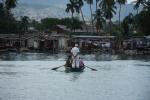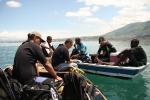Scuba Diving Bizoton Before & After
 When preparing to return to the US from my Peace Corps experience in Haiti, I was told don’t be surprised when someone asks you to describe this life changing experience, after 5 minutes don’t be surprised when they’re no longer listening. This was some great advice and so now when people ask me, “What’s Haiti like?” I find myself inevitably doing two things; first launching into curt clichés, ‘poorest country in the western hemisphere’, ‘greatest nightmare on earth’, ‘surrealism has a country’, or whatever rant I’m on that day or week but regardless I find myself always adding "...but it’s still a Caribbean island." To me that means there are still paradisiacal destinations to be found and indulge in here, but mostly for the adventurous.
When preparing to return to the US from my Peace Corps experience in Haiti, I was told don’t be surprised when someone asks you to describe this life changing experience, after 5 minutes don’t be surprised when they’re no longer listening. This was some great advice and so now when people ask me, “What’s Haiti like?” I find myself inevitably doing two things; first launching into curt clichés, ‘poorest country in the western hemisphere’, ‘greatest nightmare on earth’, ‘surrealism has a country’, or whatever rant I’m on that day or week but regardless I find myself always adding "...but it’s still a Caribbean island." To me that means there are still paradisiacal destinations to be found and indulge in here, but mostly for the adventurous.
 One of those destinations is actually the second largest in the Caribbean, Haiti’s coastline, Cuba’s first. And from many points on the coastline you can don some dive gear and get lost for an hour under the sea. Yeah, its true Haiti’s marine life is just about as depleted as its surface canapé but for divers who find more to diving than just seeing big fish Haiti has plenty to offer, but again only for the adventurous. Today’s dive especially.
One of those destinations is actually the second largest in the Caribbean, Haiti’s coastline, Cuba’s first. And from many points on the coastline you can don some dive gear and get lost for an hour under the sea. Yeah, its true Haiti’s marine life is just about as depleted as its surface canapé but for divers who find more to diving than just seeing big fish Haiti has plenty to offer, but again only for the adventurous. Today’s dive especially.
On September 21st 1928 ‘Beneath Tropic Seas’ by William Beebe was published. This is a stiffly written account of Beebe’s time in Haiti exploring the vibrant coral reef and plentitudes of fish in the bay of Port-au-Prince near Bizoton. This time was manifest destiny, US occupation time and light years away from what Bizoton is now. In Beebe’s book on the page after the title page is a photo of the 4-mast schooner he lived on and researched from near the shores of Bizoton. In the foreground are palms 60 to 80 feet tall and not a house in site. After page 14 there is an insert of a map detailing the reefs at Bizoton and other locations he was studying as well as photos showing pristine shores. Beebe writes about giant jellies, 40 pound tarpon, numerous species, vibrant reef, pelicans scooping up thousands of silversides and in dryspeak and perhaps ignorance of the genocide of sea life via bombing practice by the US military on floating targets near Lamentin Reefs just west of Bizoton.
September 20th 2009, 81 years after ‘Beneath Tropic Seas’ was published I found myself for the second time diving the Bizoton area. And I can’t imagine what the hell William Beebe was talking about. Bizoton is literally a garbage dump with shacks built on it and outhouses stilting above the water’s edge. The population amasses tires in which they use to help fill the water or barricade the waves to either create more land into the sea or protect the already teetering shanties erected there. The reefs can no longer be seen above or below water, whatever still exists of them.
 I was there to enjoy a wreck as well as assist 2 student divers. To learn to dive in Bizoton prepares you for any farm shop and more in the world. Instead of giving you chest hair it has the potential to remove your hair and replace it with perhaps festering boils. Yeah these waters aren’t clean but what can you expect from the Bay of Port-au-Prince. The wreck, the Seasprite is rumored to be a ferryboat, transporting cocaine as well as passengers perhaps. It sunk less than 10 years ago and is already covered with marine life and growth including fireworms, urchins and thorny-oysters that snap shut at the first sense of a predators presence. A goliath grouper and curious snappers hang around the vessel as well as your usual mix of juvenile fishes and moon jellies that deliver a sting all too often to unsuspecting divers.
I was there to enjoy a wreck as well as assist 2 student divers. To learn to dive in Bizoton prepares you for any farm shop and more in the world. Instead of giving you chest hair it has the potential to remove your hair and replace it with perhaps festering boils. Yeah these waters aren’t clean but what can you expect from the Bay of Port-au-Prince. The wreck, the Seasprite is rumored to be a ferryboat, transporting cocaine as well as passengers perhaps. It sunk less than 10 years ago and is already covered with marine life and growth including fireworms, urchins and thorny-oysters that snap shut at the first sense of a predators presence. A goliath grouper and curious snappers hang around the vessel as well as your usual mix of juvenile fishes and moon jellies that deliver a sting all too often to unsuspecting divers.
On a Bizoton dive its best to stay underwater as long as possible if not just to enjoy the dive but also to avoid coming up to the floating garbage wading from one shoreline to the next. Today there was an unmistakable tint of red on the surface carrying the first wave of plastic bottles, bags, orphaned sandals and sewage accompanied by a faint odor of crap. It makes even the bravest water addicts a bit hesitant to get back in for a second dive. But the students must learn! So on the second dive more of the same, the goliath grouper, frisky snappers, a territorial barracuda, wasp jellies, thorny-oysters, an ever growing population of lion fish preying on everything, barnacles, urchins, feather dusters and more. However, nothing on the scale that Beebe describes back in the 1920s is still here whether it’s under the water or above. Yes, Haiti has changed - but it is still a Caribbean island.
Add new comment